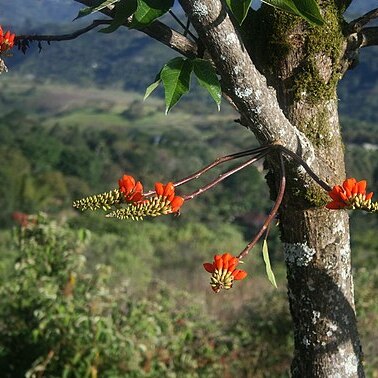Tree, sometimes armed. Leaves with leaflets ovate to broadly ovate, mostly 8-21 cm long, 5.5-16.5 cm wide, apically acute or acuminate, basally rounded, truncate, obtuse or cuneate, chartaceous or subcoriaceous, glabrous, not waxy, the principal secondary veins 7-12 on each side; costa sometimes armed; petioles puberulent, glabrescent, mostly 11-36 cm long; petiolules 3-11 cm long, 1.5-3.5 mm thick; rachises densely puberulent. Inflorescences with the bracts mostly lanceolate, to 5.2 mm long, 1.5 mm wide, the smaller ones broader; bracteoles resembling the smaller bracts but usually smaller, fruiting pedicels 0.7-1 cm long. Flowers with the calyx thin, papery, broadly campanulate, 8-11 mm long on the lower side, 7-10 mm long on the upper side, 8-10 mm wide at the mouth, the margin irregularly lobed, pubescent; standard broadly elliptic, 2-3.5 cm long, 1-2.5 cm wide, emarginate or retuse, clawed, the wings variously shaped, 3-6.5 mm long, the keel petals elongate orbicular, often lobed ventrally near the apex, 10-20 mm long; stamens 2-3.5 cm long; ovary 1.8-3 cm long, densely pubescent, stipitate. Legume somewhat woody, thick, mostly 13-25 cm long, ca. 2 cm wide, the acumen ca. 2 cm long, the stipe slender, 3.5-4.5 cm long; seeds 5-6, dark brown, 25-35 mm long, 10-18 mm wide, soft, drying wrinkled.
More
A leafy tree. It grows 14 m tall. The crown can be 7 m across. The trunk can be 37 cm across. The stem and branches have stout prickles. The leaves are alternate and have 3 leaflets. They have long leaf stalks and 2 nectar producing glands at the base of each leaflet. The flowers are in large clusters on a stout stalk. The flowers are red. The fruit hang in bunches of 9-18. They are cylinder shaped pods. The pods can be 32 cm long by 3 cm wide. They have 6 seeds. The seeds are large and succulent.
A tropical plant. In the Andes it grows between 2,000-2,800 m altitude. It can be down to 500 m above sea level. It grows in dry and moist tropics. It can be in areas with a temperature range between 5-25°C and a rainfall of 450-1,800 mm. It is best in a sunny position in a loose textured soil. It cannot tolerate soils with a pH below 4.5.
More
A pioneer species, it is usually found in open areas with disturbed soil.
The beans are boiled (for 45 minutes or more) and eaten with corn, cassava, bread or potatoes. They are also mashed with cheese, and fried. Caution: The uncooked seeds can be poisonous if eaten often.


